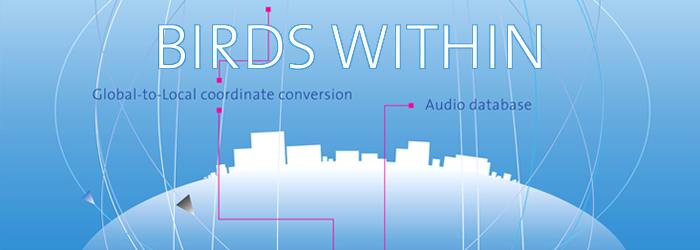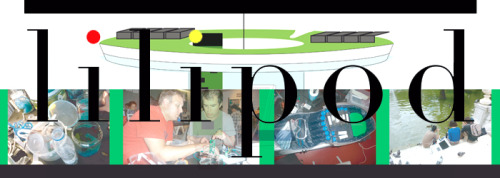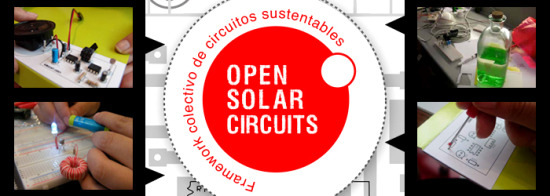Interactivos?'10: Projects Showcase

Lilipod
by Kelly Andres (Canada). Collaborators: Saoirse Higgins, Max Kazemzadeh, Reza Safavi.

Lilipods are tools for studying, implementing and monitoring DIY bioremediation efforts through community stewardship.
The initial concept and prototypes developed during the Interactivos?'10 workshop illustrate the potential for the project to cultivate a series of interactive devices for citizens to explore the sciencie of habitat remediation through hands-on and technological means.
The project merges electronic data collection and visualization, ecological research and community activism.
The first part of the project at Interactivos?'10 consisted of fieldwork by locating, collecting and mapping sources of water. Samples were processed in the Medialab-Prado's wetlab and were tested through a series of water quality indicators (pH, nitrate, BOD, dissolved, oxygen, coliform, phosphate).
Secondly, we designed a backpack-lab (Lilipac) that contains equipment to perform site analysis (water quality, habitat) and navigation with GPS. After analysis is complete the Lilipod is placed at the site. This device is a floating, leaf shaped environmental monitor with custom sensors -our frist prototype measures pH, temperature and duration.
Our intention was to design an easy to use/build device for monitoring bioremediation progress in situ that facilitates the transmission of custom sensor data to shore-bound individuals via Bluetooth. The third part of the project in development is an application for mobile devices (Processing) to communicate and visualize the data from the Lilipod. Lastly, we imagine a web platform that serves as a repository for each project; for mapping the sites of remediation that are in progress for data logs that are collected from the lilipod devices, and for sharing techniques/information on DIY bioremediation.
Open Solar Circuits
by DreamAddictive (Carmen González & Leslie García) (Mexico). Collaborators: Giuseppe Burdo, Jennifer Dopazo, Maria Paula Falla, Simonetta Gorga, Mauricio Martins, Yago Torroja.

Open Solar Circuits is a project that works as a framework for collective construction, making a system of the knowledge obtained during the experimentation process, to be reproduced later in different contexts. The project is focused on experimenting with sustainable electronic circuits.
Re:tag
by Sandra Dávila (USA/Mexico). Collaborators: Sergio Galán, Federico Andrade, Adolfo Estalella, Rodrigo Calvo, Carlos Cochón, Marianna Suarez, Gabriel Lucas, Madeleine Claire Elish.

Re:tag is a tagging system that fosters the emotional connection between people and objects. Hence, those objects that had been thrown out (by being left on the margin of the economic system) are rescued in the emotional exchange, and get a new use through collective oral stories.
People that want to get rid of their belongings, furniture or any object, leave a voice message in a database describing the history of the object. A tag with a unique id number and a phone number will be added to the object before being included in the project. By dialing the phone and id numbers, participants will e able to listen to the story behind the object. The goal is to constitute a self-sufficient and permanent voice tagging system that can be used by recycling organizations responsible for discarded objects.
Algas Verdes
by Hamilton Mestizo (Colombia). Collaborators: Allison Kudla, Joaquín Rodríguez, Montfragüe Fernández Lavandera, Donacio Cejas Acosta, Nirvana Soltani.

We are working to develop and produce a cheap, DIY and easy-to-assemble photobioreactor (PBR). The photobioreactor will permit the cultivation of Green Algae Chlorophyta which will be mapped and collected around Medialab-Prado and the city of Madrid.
The PBR's inbuilt sensors will detect gas levels (O2, Co2, H), tempreature and calculate biomass (Photoresistors) thereby provididn us with informations about the state of the internal atmosphere. This will allow us to observe the algae's behaviour, the iochemical reactions and the adaptations as they occur.
The photobioreactor has the folowing inputs and outputs:
Input: Human exhalation (co2) contained in our breath serves as food for algae. Output: Oxygen (O2) + Hydrogen /H).
http://algasverdes.blogspot.com
http://algasverdes.librepensante.org
VirtualUrban
by Rory Solomon (USA). Collaborators: Acitore Artezione, Alfonso Montón, Christian Duell, Jennifer Sarich-Harvey, Milos Jovanovic. Remote member: Marek Walczak.

VirtualUrban is an exploration of the relationship between the real and the virtual in urban space.
The project: We begin with a neigbourhood and hold community workshops in order to build a vocabulary of 3D forms. These forms become the building blocks of a virtual world, which is then presented as a site-specific, augmented reality exhibition within the neighbourhood.
The installation: Multi-user augmented reality. 3D forms are projected onto a translucent surface which allows the viewer to experience the real and virtual worlds simultaneously. During the installation the viewer has the opportunity to build and navigate a unique 3D virtual world. In this context, the viewer is able to reinterpret both the seen and unseen qualities of their neighbourhood.
Site Specific Setup: The site specific setup requires the integration of a system of basic elements adaptable to various locations.
Birds within
by Luis Bustamante (Colombia). Collaborators: Francisco Toro, Nacho Cossio, Nacho Gómez, Agustin Batista, Aurelio Carnero R., Javier Blanco.

http://wiki.medialab-prado.es/index.php/Birds_within
protonumerique.net
aconnectiontoaremoteplace.net
http://bogotadeclaration.wordpress.com/
http://www.svengrahn.pp.se/sounds/sounds.htm
Control Mental
de Maurizio Dikdan (Venezuela). Collaborators: Yago Torroja, Mauricio Martins y Gatopan.

The project is an oscilloscope that shows a Lissajous curve shaped depending on the blood pressure values of the visitor.
The goal of the project is to generate an alternative way of representing these values. By observing the simetry (or asimetry) of the curves generated by the blood pressure of the individual we can create a more intuitive way so anyone without any medical background can check if he or she is ok or in risk.
First we created a functional prototype that generates a curve depending on the values of the person. As a further developement, we want to add a sound component that uses the armonic nature of the Lissajous curves, and to implement a database to the system so we can track the values of groups of people and, therefore, make conclusions about the health conditions of a collective.
The project uses a CRT television modified in order to act as an oscilloscope, an Esfigmomanometer, a microprocessor and two amplifiers.
Society of Urban Naturalists
de Emilio Zamudio (México). Colaboradores: Carolina Gruffat, Christina Kral, Ivonne Villamil, Héctor Cataño.

The Society of Urban Naturalists (S.U.N.) is an international collective of urban researchers dedicated to discover the hidden relationships between nature, city and humanity.
S.U.N. approaches the same problems that science studies but through city inhabitants, using different methods and invented devices, in order to interact or observe the interactions between humans and their natural/urban environment.
For this research cycle, the Society chose the Retiro Park as a common playground and starting point. The park is a hybrid that gathers three key aspects for the research and is convieniently located near Medialab-Prado.
Methods and proposals of the Society include: research through a game board using simple shapes found on the spot and a set of rules to involve people in the park and make them think about the interconnections between nature-city-humanity, a research format that includes detective style and real fiction, as well as a thorough collection of hybrids found by making new associations, cataloging finds in order to contribute to the folksonomy of a new nature.
http://strangestforest.tumblr.com/
IceCap [Automated Collapsible Forms]
by Erika Lincoln (Canada). Collaborators: Fernanda Reis, Helena Lillo, Irma Földényi, Mauricio Martins, Natasha Karpikova.

The Project: To create a kinetic paper sculpture in the form of an Arctic Ice Cap that shrinks in the Madrid sun using solar power cells. The sculpture is intended to highlight climatological predictions surrounding the shrinking of the Polar Ice Cap which covers the Arctic sea. This project focused on the experimental design and construction of a kinetic paper sculpture that collapses with the aide of motors, string, and solar power.
Through the IceCap project we seek to create both an evocative kinetic sculpture and to address issues surrounding the predictedmelting of the Arctic Ice Cap.
Biological Plastic Toys
by Brian Degger (UK). Collaborator: Nirvana Soltani.

Biological Plastic is a substance that can be molded, shaped, formed into sheets, cut and colored much like normal oil based plastics. However, it uses easily obtained materials, with no irritants stronger than vinegar. All of it’s components can be sourced from groceries, supermarkets or chemists.
No Logo: These toys are meant to be de-comodified objects of play for fairytales that are made by the storyteller to teach them about the wonders and dangers of the community they are growing up in.



 Medialab-Matadero Madrid
Medialab-Matadero Madrid